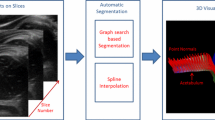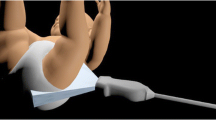Abstract
Purpose
Developmental dysplasia of the hip (DDH) is a congenital deformity which in severe cases leads to hip dislocation and in milder cases to premature osteoarthritis. Image-aided diagnosis of DDH is partly based on Graf classification which quantifies the acetabular shape seen at two-dimensional ultrasound (2DUS), which leads to high inter-scan variance. 3D ultrasound (3DUS) is a promising alternative for more reliable DDH diagnosis. However, manual quantification of acetabular shape from 3DUS is cumbersome.
Methods
Here, we (1) propose a semiautomated segmentation algorithm to delineate 3D acetabular surface models from 3DUS using graph search; (2) propose a fully automated method to classify acetabular shape based on a random forest (RF) classifier using features derived from 3D acetabular surface models; and (3) test diagnostic accuracy on a dataset of 79 3DUS infant hip recordings (36 normal, 16 borderline, 27 dysplastic based on orthopedic surgeon assessment) in 42 patients. For each 3DUS, we performed semiautomated segmentation to produce 3D acetabular surface models and then calculated geometric features including the automatic \(\mathrm{a}\)lpha (AA), acetabular contact angle (ACA), kurtosis (K), skewness (S) and convexity (C). Mean values of features obtained from surface models were used as inputs to train a RF classifier.
Results
Surface models were generated rapidly (user time 46.2 s) via semiautomated segmentation and visually closely correlated with actual acetabular contours (RMS error 1.39 ± 0.7 mm). A paired nonparametric u test on of feature values in each category showed statistically significant variation (p < 0.001) for AA, ACA and convexity. The RF classifier was 100 % specific and 97.2 % sensitive in classifying normal versus dysplastic hips and yielded true positive rates of 94.4, 62.5 and 89.9 % for normal, borderline and dysplastic hips.
Conclusions
The proposed technique reduces the subjectivity of image-aided DDH diagnosis and could be useful in clinical practice.








Similar content being viewed by others
References
Furnes O, Lie S, Espehaug B, Vollset S, Engesaeter L, Havelin L (2001) Hip disease and the prognosis of total hip replacements—a review of 53 698 primary total hip replacements reported to the Norwegian arthroplasty register 1987–99. J Bone Jt Surg Br 83(4):579–586
Dezateux C, Rosendahl K (2007) Developmental dysplasia of the hip. Lancet 369(9572):1541–1552
Bache CE, Clegg J, Herron M (2002) Risk factors for developmental dysplasia of the hip: ultrasonographic findings in the neonatal period. J Pediatr Orthop B 11(3):212–218
Clarke N, Clegg J, Al-Chalabi A (1989) Ultrasound screening of hips at risk for CDH. Failure to reduce the incidence of late cases. J Bone Jt Surg Br 71(1):9–12
Graf R (1984) Fundamentals of sonographic diagnosis of infant hip dysplasia. J Pediatr Orthop 4(6):735–740
Mabee M, Dulai S, Thompson RB and Jaremko JL (2014) Reproducibility of acetabular landmarks and a standardized coordinate system obtained from 3D hip ultrasound. Ultrason Imaging 37(4):267–276. doi:10.1177/0161734614558278
Jaremko JL, Mabee M, Swami VG, Jamieson L, Chow K, Thompson RB (2014) Potential for change in US diagnosis of hip dysplasia solely caused by changes in probe orientation: patterns of alpha-angle variation revealed by using three-dimensional US. Radiology 273(3):870–878
Cheng E, Mabee M, Swami VG, Pi Y, Thompson R, Dulai S, Jaremko JL (2015) Ultrasound quantification of acetabular rounding in hip dysplasia: reliability and correlation to treatment decisions in a retrospective study. Ultrasound Med Biol 41(1):56–63
Yavuz OY, Uras I, Tasbas BA, Ozdemir MH, Kaya M, Komurcu M (2014) A new measurement method in Graf technique: Prediction of future acetabular development is possible in physiologically immature hips. J Pediatr Orthop 34(6):591–596
Hareendranathan AR, Mabee M, Punithakumar K, Noga M, Jaremko JL (2016) Toward automated classification of acetabular shape in ultrasound for diagnosis of DDH: contour \(\alpha \) and the rounding index. Comput Methods Programs Biomed 30(129):89–98
Mabee MG, Hareendranathan AR, Thompson RB, Dulai S, Jaremko JL (2016) An index for diagnosing infant hip dysplasia using 3-D ultrasound: the ACA. Pediatr Radiol 11:1–9
Zoroofi R, Sato Y, Sasama T, Nishii T, Sugano N, Yonenobu K, Yoshikawa H, Ochi T, Tamura S et al (2003) Automated segmentation of acetabulum and femoral head from 3-D CT images. IEEE Trans Inf Technol Biomed 7(4):329–343
Kainmueller D, Lamecker H, Zachow S and Hege H-C (2009) An articulated statistical shape model for accurate hip joint segmentation. In: Annual international conference of the IEEE engineering in medicine and biology society, 2009. EMBC 2009
Gilles B, Moccozet L, Magnenat-Thalmann N (2006) Anatomical modelling of the musculoskeletal system from MRI. In: Larsen R, Nielsen M, Sporring J (eds) Medical image computing and computer-assisted intervention-MICCAI. Springer, Berlin, pp 289–296
Beek M, Abolmaesumi P, Luenam S, Ellis RE, Sellens RW, Pichora DR (2008) Validation of a new surgical procedure for percutaneous scaphoid fixation using intra-operative ultrasound. Med Imag Anal 12(2):152–162
Jain AK, Taylor RH (2004) Understanding bone responses in B-mode ultrasound images and automatic bone surface extraction using a bayesian probabilistic framework. In: Medical imaging 2004. International Society for Optics and Photonics, pp 131–142
Kowal J, Amstutz C, Langlotz F, Talib H, Ballester MG (2007) Automated bone contour detection in ultrasound B-mode images for minimally invasive registration in computer-assisted surgery—an in vitro evaluation. Int J Med Robot Comput Assist Surg 3(4):341–348
Hacihaliloglu I, Abugharbieh R, Hodgson AJ, Rohling RN, Guy P (2012) Automatic bone localization and fracture detection from volumetric ultrasound images using 3-D local phase features. Ultrasound Med Biol 38(1):128–144
Quader N, Hodgson A, Mulpuri K, Savage T, Abugharbieh R (2015) Automatic assessment of developmental dysplasia of the hip. In: IEEE 12th international symposium on biomedical imaging (ISBI) 2015, pp 13–16, 16–19
Luis-Garcia D, Alberola-Lopez C et al. (2006) Parametric 3D hip joint segmentation for the diagnosis of developmental dysplasia. In: 28th Annual international conference of the IEEE engineering in medicine and biology society, 2006. EMBS’06
Abhilash RH, Mabee M, Punithakumar K, Noga M and Jaremko JL (2015) A technique for semi-automatic segmentation of echogenic structures in 3DUS, applied to infant hip dysplasia. Int J Comput Assist Radiol Surg 11(1):31–42
Mortensen EN, Barrett WA (1998) Interactive segmentation with intelligent scissors. Gr Models Imag Process 60(5):349–384
Hamarneh G, Yang J, McIntosh C, Langille M (2005) 3D live-wire-based semi-automatic segmentation of medical images. In: Medical imaging 2005. International Society for Optics and Photonics, pp 1597–1603
Falcao AX, Udupa JK (1997) Segmentation of 3D objects using live wire. In: Medical imaging 1997. International Society for Optics and Photonics, pp 228–235
Li K, Wu X, Chen DZ, Sonka M (2006) Optimal surface segmentation in volumetric images-a graph-theoretic approach. IEEE Trans Pattern Anal Mach Intell 28(1):119–134
Dijkstra EW (1959) A note on two problems in connexion with graphs. Numer Math 1(1):269–271
Breiman L (2001) Random forests. Mach learn 45(1):5–32
Acknowledgements
We thank Dr. Pierre Boulanger (Professor, Department of Computing Science) and Dr. Richard Thompson (Associate Professor, Department of Biomedical Engineering) for their insight and expertise that greatly helped in this research.
Author information
Authors and Affiliations
Corresponding author
Ethics declarations
Funding
This work was funded in part by the CIHR– Sick Kids Foundation New Investigator Research Grant 201401SKF and Capital Health Endowment in Diagnostic Radiology, Radiologic Society of North America (RSNA) Research Seed Grant and Servier Canada
Conflict of interest
The authors Abhilash Rakkunedeth Hareendranathan, Dornoosh Zonoobi, Myles Mabee, Chad Diederichs, Kumaradevan Punithakumar, Michelle Noga and Jacob L. Jaremko declare that they have no conflict of interest
Ethical approval
All procedures followed were in accordance with the ethical standards of the responsible committee on human experimentation (institutional and national) and with the Helsinki Declaration of 1975, as revised in 2008 (5).
Informed consent
Informed consent was obtained from all patients for being included in the study
Rights and permissions
About this article
Cite this article
Hareendranathan, A.R., Zonoobi, D., Mabee, M. et al. Semiautomatic classification of acetabular shape from three-dimensional ultrasound for diagnosis of infant hip dysplasia using geometric features. Int J CARS 12, 439–447 (2017). https://doi.org/10.1007/s11548-016-1510-4
Received:
Accepted:
Published:
Issue Date:
DOI: https://doi.org/10.1007/s11548-016-1510-4




